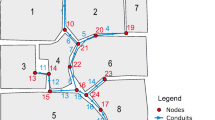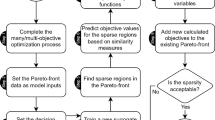Abstract
Decision making regarding Sustainable Urban Drainage Systems (SUDS) sitting is an analytical complex process, as it involves the evaluation of a high number of environmental, physical and technical considerations. Additionally, as the resources are always limited (e.g. budget and land availability), the prioritization of sub-catchments for SUDS placement would help decision makers to determine where is most beneficial to locate these infrastructures. This study proposes a methodology that couples an urban drainage model and Mixed Integer Linear Programming (MILP) to determine where is more beneficial to locate SUDS to reduce both runoff volumes and combined sewer overflows (CSOs). To achieve this goal, the City Drain model is used to model the runoff generation and the flows among sub-catchments. Three indexes are proposed to quantify the reduction on both CSO and runoff volumes, and a lexicographic multi-objective model is used to find the prioritized sub-catchments within a city. The methodology was applied to sub-catchments of Bogotá (Colombia), comprising an area of 38 km2. Preliminary results showed that the prioritized sub-catchments were highly dependent on land availability and the optimal solution did not necessarily involve the selection of the sub-catchments that yield most runoff. This study demonstrates the importance and usefulness of the prioritization tool for SUDS planning, which can be used by other large cities like Bogotá.
Access provided by Autonomous University of Puebla. Download conference paper PDF
Similar content being viewed by others
Keywords
1 Introduction
Sustainable Urban Drainage Systems (SUDS) are engineered-as-natural multifunctional systems whose performance depend on their spatial location (Zhang et al. 2018). The strategic planning for SUDS sitting involves the type selection, design and sizing on individual practices at different spatial scales. Given the multi-objective nature of SUDS, the objectives of such planning strategies can vary such as reduction of runoff volumes, reduction of a target pollutant and social benefits (Yang and Best 2015). During the last decades, researches have applied optimization techniques to deal with the spatial allocation problem in small to medium-size drainage areas. However, few studies have been conducted at a city-wide or larger scale. Previous works have used Geographical Information Systems (GIS) to preliminarily determine feasible locations of SUDS at large scales (cities and nation-wide scales) (Wickham et al. 2010), but no optimization technique has been applied to find the optimal configuration at such a scale. This work aims to identify the prioritized sub-catchments and SUDS areas that minimize both runoff and combined sewer overflows (CSOs) volumes using a Mixed Integer Linear Program (MILP). This prioritization is important for decision makers to focus efforts and budget in the detailed design of spatial configuration of SUDS within prioritized sub-catchments.
2 Materials and Methods
The methodology herein proposed starts with the processing of spatial data in GIS to obtain the parameters required by the MILP. Results from the optimization model are loaded into GIS platform for visualization.
2.1 The GIS Pre-processing
A satellite image is used for identifying pervious and impervious surface and assigning runoff coefficient values, initial and permanent rainfall losses. Additionally, from the surface classification analysis the available area for SUDS installation is approximated as a percentage of the green area (e.g. gardens, parks, green corridors) per sub-catchment. The precipitation information is georeferenced, and a kriging interpolation is carried out to obtain rainfall series inputs for the gauged and ungauged sub-catchments.
2.2 The Urban Drainage Model (UDM)
The methodology proposes the use of City Drain II, an opensource toolbox developed in the Matlab/Simulink® environment. City Drain II implements a simple conceptual model that offers short simulation by means of solving discrete formulations of Muskingum method to model flow transportation (Achleitner et al. 2007). City Drain II implements both the catchment loss model and the catchment flow model to convert rainfall to runoff flows.
Rainfall series processed in step 1 (see Fig. 1) are used as an input to City Drain II to calculate runoff water and CSOs series. SUDS implementation is modelled as a percentage of area that is changed from impervious to pervious surface, which means modifying two parameters in the UDM: runoff coefficient and depressions storage coefficient. The effect of SUDS is measured as the difference in runoff volume, peak flow and CSOs volume, compared to the baseline condition (without SUDS implementation). Using Eq. 1, a set of reduction indexes, (\( RI_{i} \)), are calculated to asses the effect of SUDS implementation, where  corresponds to: Runoff Reduction Index (RRI), CSOs Reduction Index (CSORI) and Peak Runoff Volume Reduction Index (PRRI). In Eq. 1, \( f\left( t \right) \) is the time series observed without SUDS implementation and \( f^{{\prime }} \left( t \right) \) is the time series observed when an area of SUDS is implemented.
corresponds to: Runoff Reduction Index (RRI), CSOs Reduction Index (CSORI) and Peak Runoff Volume Reduction Index (PRRI). In Eq. 1, \( f\left( t \right) \) is the time series observed without SUDS implementation and \( f^{{\prime }} \left( t \right) \) is the time series observed when an area of SUDS is implemented.
2.3 The Optimization Model
The mathematical model proposes a piecewise linear approximation of the index  functions using a set of lines
functions using a set of lines  for sub-catchments
for sub-catchments  . The model is built upon the assumption that there is a linear behaviour between two SUDS installation areas in terms of reduction indexes.
. The model is built upon the assumption that there is a linear behaviour between two SUDS installation areas in terms of reduction indexes.  and
and  are the upper and lower limits of the abscissa (SUDS installation area) of the line-segment
are the upper and lower limits of the abscissa (SUDS installation area) of the line-segment  of the sub-catchment
of the sub-catchment  , while
, while  and
and  are the slope and intercept segment
are the slope and intercept segment  of the sub-catchment
of the sub-catchment  and index
and index  . Variable
. Variable  indicates 1 if the area to be installed in sub-catchment
indicates 1 if the area to be installed in sub-catchment  is within the range of the segment
is within the range of the segment  and
and  is the variable representing the value of the SUDS area.
is the variable representing the value of the SUDS area.  is defined as the total index (sum of all installed SUDS contributions) for the sub-catchment
is defined as the total index (sum of all installed SUDS contributions) for the sub-catchment  and index
and index  .
.  is calculated as expressed in Eq. 2.
is calculated as expressed in Eq. 2.

The lexicographic multi-objective or \( \varepsilon \)-constraint method (Cococcione et al. 2018) consists on solving three sequential MIP models, each corresponding to the maximization of one of the indexes. The first step model seeks to maximize sum of RRI index, the second one the CSORI and the third the PRRI index, as illustrated in Fig. 1. Each subsequent step involves the addition of one constraint that limits the detriment of the previous step’s objective value.

3 Results and Discussion
The methodology was applied to a subset of sub-catchments of Bogotá city. In total 48 sub-catchments (comprising 38 km2) located in the northwest of the city were considered for SUDS implementation. By means of a 1-meter resolution 3-band satellite image, green areas were identified within each sub-catchment. Results showed that for more than 70% of the sub-catchments, the green area correspond to less than 30% of the surface area. As a proxy, a percentage of the green area was used to define the area availability for SUDS sitting (which corresponds to the maximum area that can be installed in each sub-catchment). 5 SUDS installation areas per sub-catchment were modelled per sub-catchment using an average year precipitation daily series and the runoff and CSOs series were extracted from City Drain II. Results were obtained for 4 different available-for-SUDS-installation areas and are summarized in Table 1. Higher indexes values are obtained for larger installation areas (indicating higher reductions of runoff and CSO) and a higher number of catchments were selected from the original set of 48 catchments. The spatial distribution of selected catchments is illustrated in Fig. 2, which shows the distribution of the optimal solution. By comparing with the simple ranking in term of highest reduction indexes, the results showed that the optimal solution does not necessarily involve the selection of the of “best” isolated sub-catchments. The model also determined the SUDS area to be installed in each sub-catchment, results showed that SUDS areas varied from 100 m2 to 2400 m2.
4 Conclusions
The proposed methodology was successfully tested in a subset of sub-catchments of Bogotá city. The model was able to determine the spatial distribution that optimizes the reduction of runoff and CSOs volumes. Two questions were answered using the methodology: in which sub-catchments and what area per sub-catchment should be designated for SUDS installation. This information is valuable for decision makers to understand where efforts and resources should be focused to develop further analysis: e.g. which SUDS typology and where exactly within the sub-catchment the SUDS are to be installed. Current work is focused in applying the model in the whole city area and applying a stochastic MIP to consider several precipitation scenarios with corresponding probabilities of occurrence.
References
Achleitner, S., Moderl, M., Rauch, W.: CITY DRAIN © An open source approach for simulation of integrated urban drainage systems. Environ. Model Softw. 22(8), 1184–1195 (2007)
Cococcioni, M., Pappalardo, M., Sergeyev, Y.D.: Lexicographic multi-objective linear programming using grossone methodology: theory and algorithm. Appl. Math. Comput. 318, 298–311 (2018)
Wickham, J.D., Ritters, K.H., Wade, T.G., Vogt, P.: A national assessment of green infrastructure and change for the conterminous United States using morphological image processing. Landsc. Urban Plan. 94, 186–195 (2010)
Yang, G., Best, E.P.H.: Spatial optimization of watershed management practices for nitrogen load reduction using a modeling-optimization framework. J. Environ. Manag. 161, 252–260 (2015)
Zhang, K., Chui, T.F.M.: A comprehensive review of spatial allocation of LID-BMP-GI practices: strategies and optimization tools. Sci. Total Environ. 621, 915–929 (2018)
Author information
Authors and Affiliations
Corresponding author
Editor information
Editors and Affiliations
Rights and permissions
Copyright information
© 2019 Springer Nature Switzerland AG
About this paper
Cite this paper
Torres, M.N., Zhu, Z., Rodríguez, J.P. (2019). A Prioritization Tool for SUDS Planning in Large Cities by Coupling an Urban Drainage Model with Mixed Integer Linear Programming. In: Mannina, G. (eds) New Trends in Urban Drainage Modelling. UDM 2018. Green Energy and Technology. Springer, Cham. https://doi.org/10.1007/978-3-319-99867-1_25
Download citation
DOI: https://doi.org/10.1007/978-3-319-99867-1_25
Published:
Publisher Name: Springer, Cham
Print ISBN: 978-3-319-99866-4
Online ISBN: 978-3-319-99867-1
eBook Packages: EnergyEnergy (R0)






